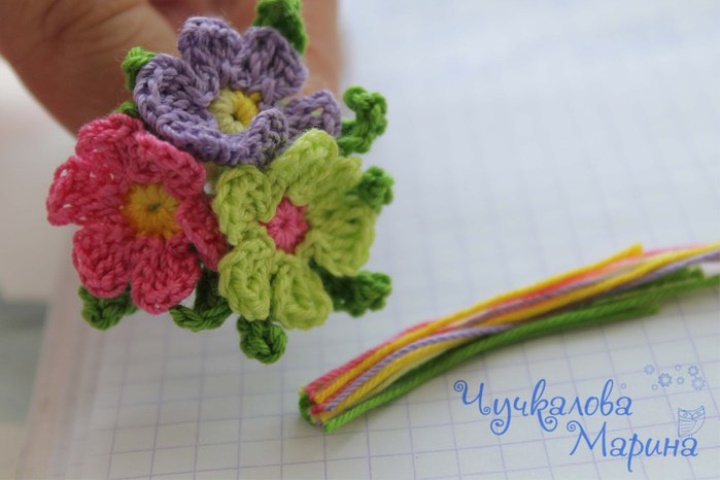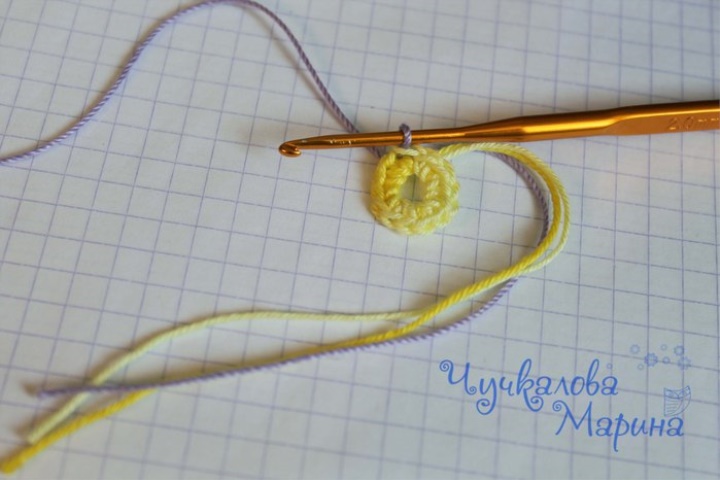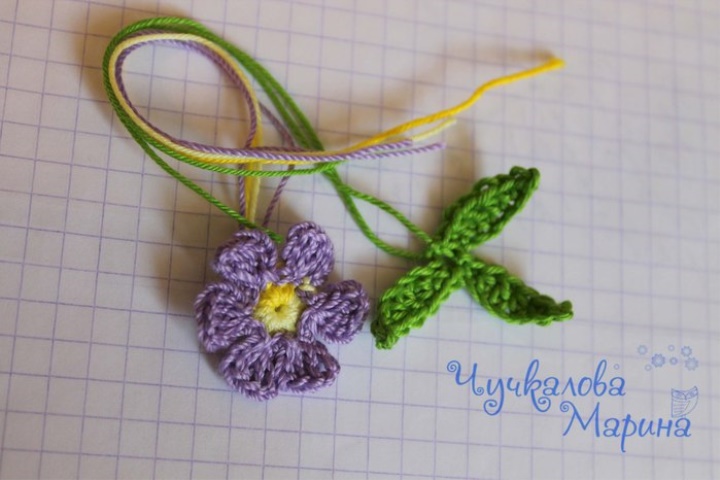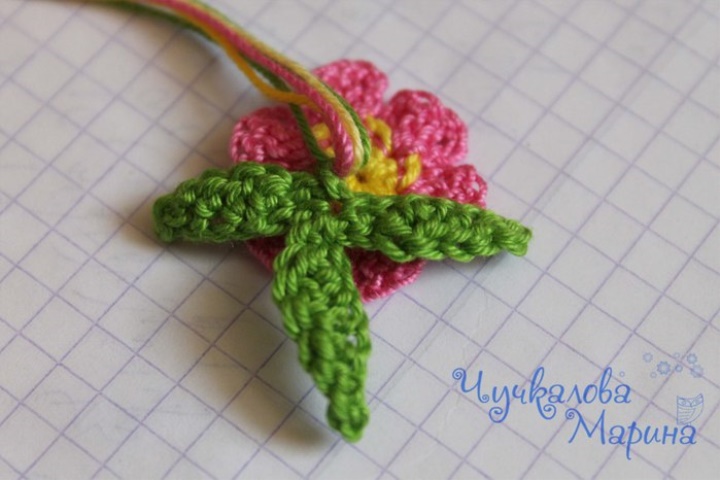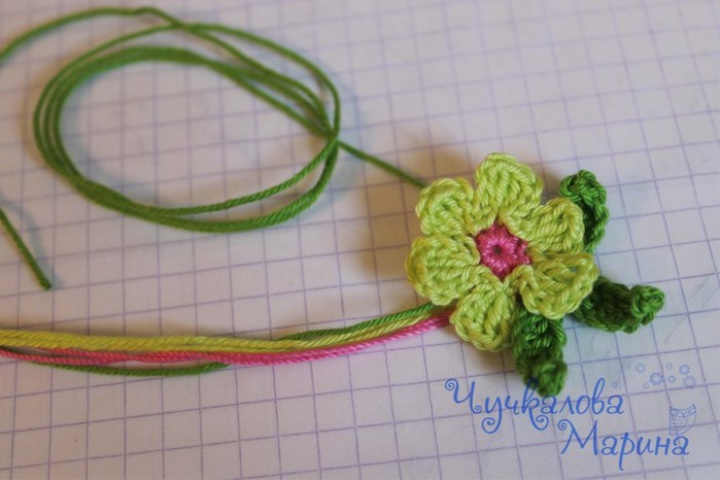Click For Crochet Abbreviations List
We will need:
* white yarn (I have 40% Nako mohair)
* a little black yarn (preferably the same thickness as white)
* yarn for scarves and a bunch (I have Coco cotton)
* hook # 2
* beads for eyes
* filler
* needle
* super glue
* and there may be something else interesting that can be found in your chests and boxes)))
Legend:
• n. - loop
• ce. - air loop
• sbn - column without nakida
• pr. - increase
• killer - decrease
• PSSN - semi column with nakida
• CCH - column with nakida
• SS - connecting loop
Stage I
Head-trunk-legs (one piece) We
collect a chain from 8 vp
1) In the second n. From the hook, we knit 2 sbn (i.e., etc.), 5 sbn, 4 sbn in one loop (so we find ourselves on the other side), 5 sbn, ave. (18)
2) 2 ave. 5 Bbn, 4 Ave., 5 Bbn, 2 Ave. (26)
Now you can make a mark with a thread of a contrasting color, as the rows will knit further without changes (I do this to relax a little and not count loops and rows)
3-12 ) 10 rows unchanged
Next, we will knit, making increases on the sides. To increase accounted for exactly in the center, we knit 3 stb and thereby displace the beginning of our series a little.
13) 12 sat, pr - 2 times (28)
14) unchanged
15) 13 sat, pr - 2 times (30)
16) unchanged
17) 14 sat, pr - 2 times (32)
18) unchanged
19) 15 sc, etc. - 2 times (34)
20) no change
21) 16 sc, etc. - 2 times (36)
22) no change
no forget about the filler
23) 17 sc, etc. - 2 times (38)
24) 18 sc , pr - 2 times (40)
25) 19 sbn, pr - 2 times (42)
26) 20 sbn, pr - 2 times (44)
27) 21 sbn, pr - 2 times (46)
28-32) 5 rows unchanged
33) 21 SBN, kill - 2 times (44)
34) 20 sat, kill - 2 times (42)
35) 19 sat, kill - 2 times (40)
36) 18 sat, kill - 2 times (38)
37) 17 sat, kill - 2 times (36)
We make legs . And, as you might have guessed, we will knit them the same way as in Shlepkin, Minik or Konik.
Leg:
Knit 5 sbn, connect with the opposite side of the part so that we have a circle consisting of 10 loops. Next, knit 4 rows without changes. Looped (I did it with a needle)
Just knit and the other leg.
We sew a hole (!!! do not forget to put the filler !!! Make the filler tight in the legs)
here's what should happen:
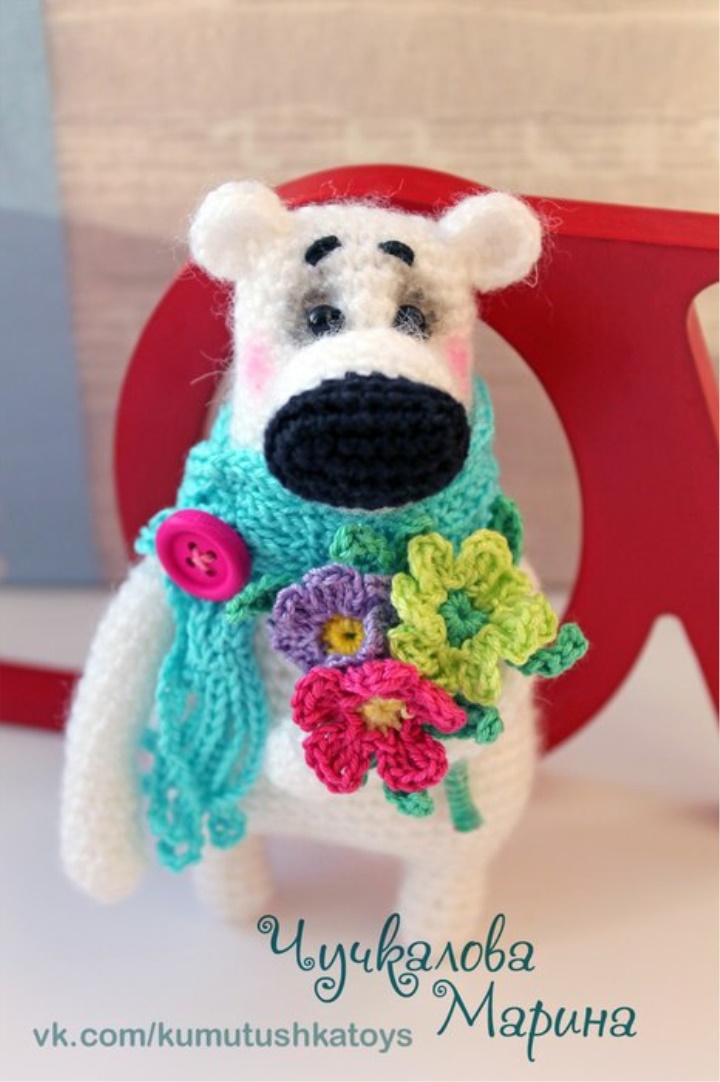
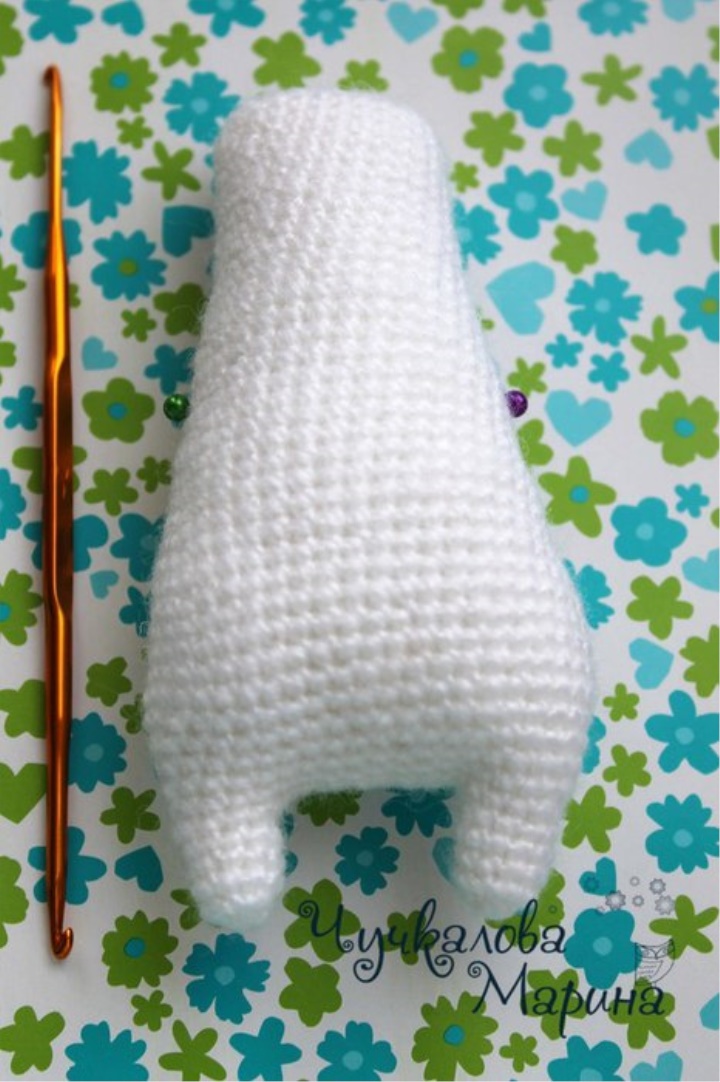
Stage II
Nose:
Begin to knit with black thread
Recruit a chain of 8 vp
1) In the second paragraph from the hook, we knit 6 sbn, 3 sbn into the last n chains (so we are on the other side), 5 sbn, ave. (16)
2) ave, 5 sbn, 3 ave., 5 sbn, 2 pr. (22)
3) unchanged
4) kill, 5 sat, 3 kill, 5 bond, 2 kill (16)
5) (we will knit further with a white thread) unchanged (16)
6) 3 hook, ave. 2 times ( 20)
7-10) 4 rows without changes
We leave the thread for sewing. Put the filler, counting 6 rows from the top and sew.
Feet:
9 sbn in amigurumi ring. Next, knit without changes 19 rows. Lightly stuffed foot, loops hurt. We sew the legs to the body. Again, I looped the loops with a needle, and then I sewed them immediately.
What mohair is good for is that when sewing it is not visible any flaws. All camouflaged hairiness))))
Ears:
9 sbn in the ring amigurumi, ce, overturn the knitting and knit 9 sbn.
Should turn out semicircles. We leave the thread for sewing. Sew on)))
Tail:
1) 6 sbn in the ring amigurumi
2) 6 gains (12)
3-5) 3 rows without changes (12)
Tail sew to the body.
Make a face: sew eyes, embroider eyebrows, ulybochku. I am still tinting around the peephole (and it is better to do this before sewing them)
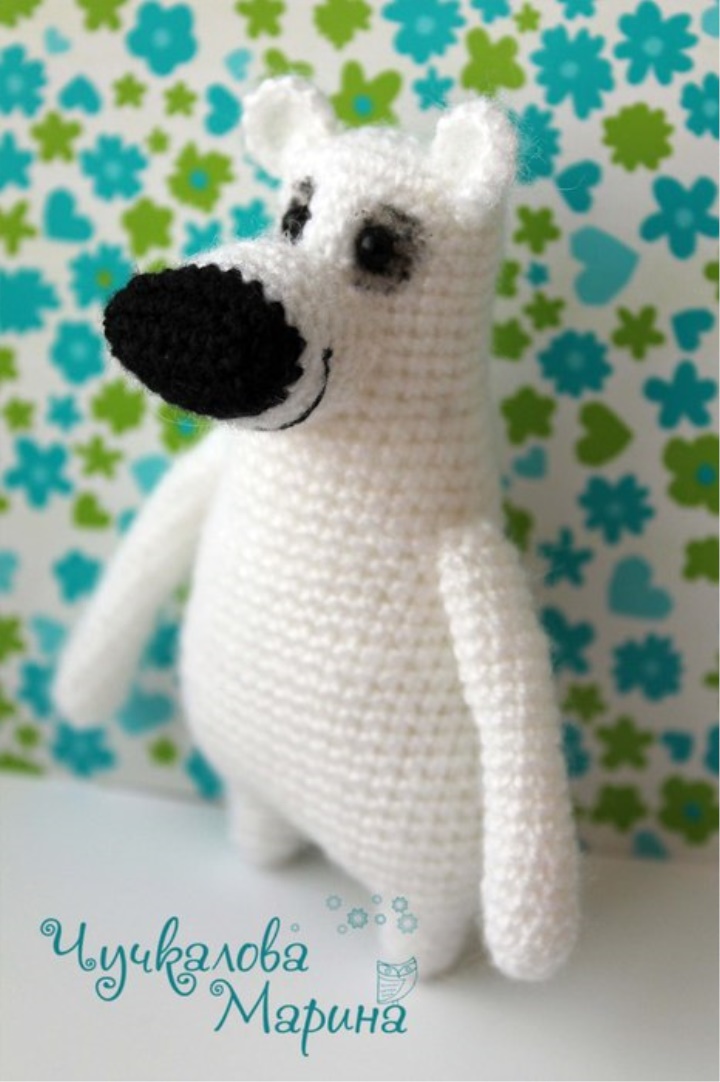

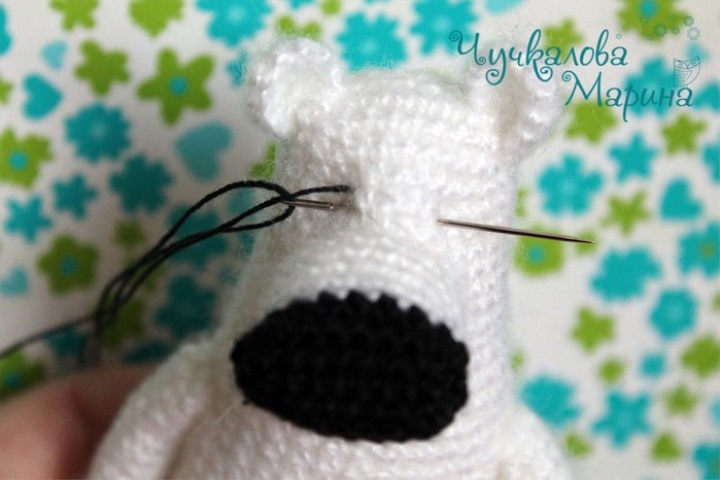
Scarf:
I have already knitted such scarves a couple of pieces: for myself and for the eldest. And then I decided to dress my toys in my favorite scarf.
Its author, Marina Arkhangelskaya, is called “airy”.
The beauty of scarf is that it starts to knit from the long side and its width can be any.
Now let's tie such an air scarf for the bear.
Tie a chain of 66 VP (or another length, but the number of loops is a multiple of 6) + 30 ce - for brush fringe. In the first row, tie 1 kn to the 31st loop from the hook (the loop on the hook does not count loops). Then knit * 5 ce, miss 5 loops of the chain, and in the 6th knit 1 knit * - repeat between * ... * until the end of the row. At the end of the row, tie 30 ip. for the fringe brush and start the 2nd row by doing the 1st sbn over the last sbn of the previous row and then following the scheme.
Tie a scarf to the required width. At the edges of the scarf you will get knitted fringe.
You can vary the length and width of the scarf at your discretion by increasing or decreasing the initial chain and the number of knitting rows. The number of loops in the initial chain is a multiple of six (the fringe is not taken into account).
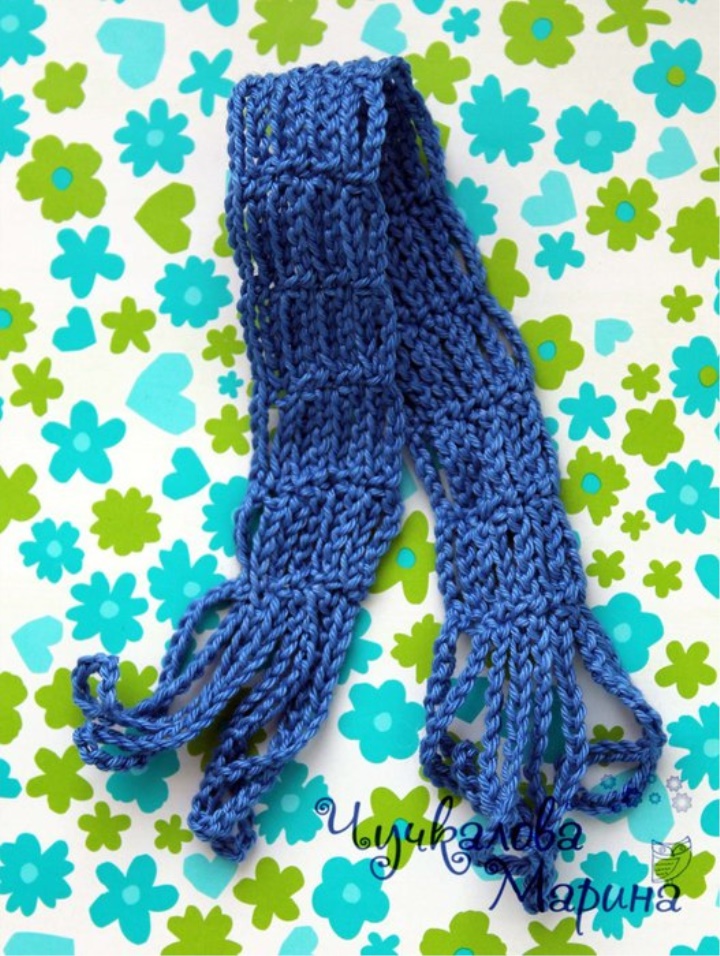
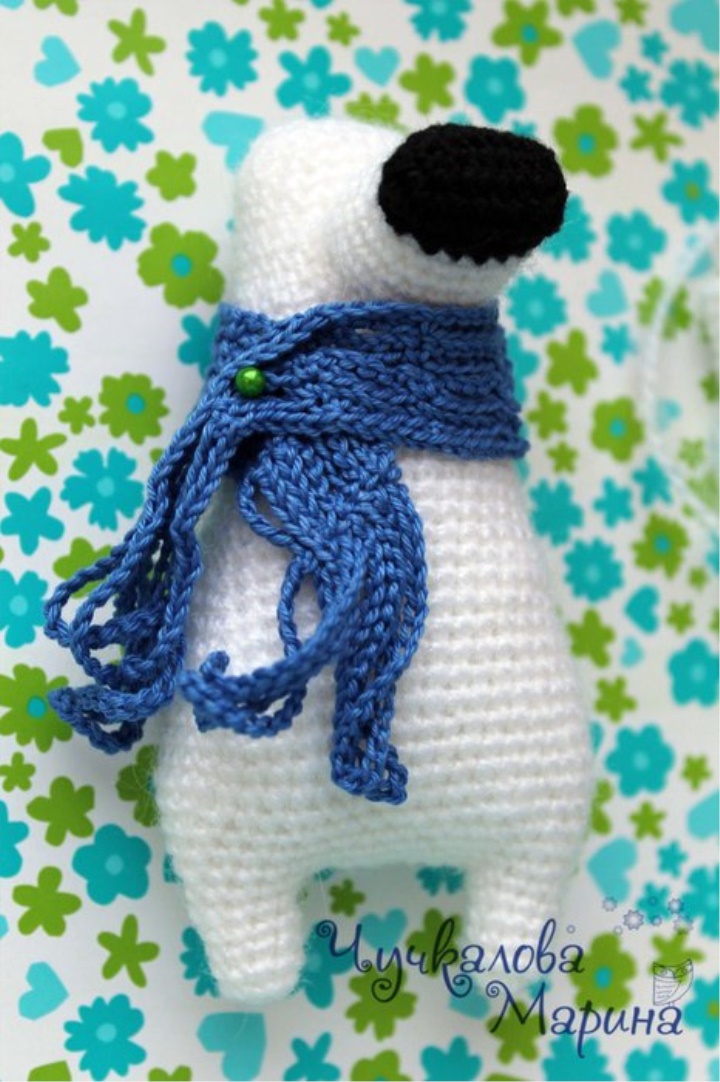

A bouquet of flowers:
We link three flowers of different flowers and each flower has three green trefoils.
Whenever loops are set in an amigurumi ring or in a chain, leave a tail of 10 cm in length. Then we will gather these tails together.
How to tie a flower:
1) We type 12 ambigumi with yellow thread in a ring (don’t forget about the tail)
2) Change the color, for example, to lilac and knit the first petal:
ONE AND THAT SCOOK - * ss, 3 points , 2 CCH, 3 vp, ss *
Next ss to the next loop. And next we knit a new petal again, i.e. everything between the stars is repeated again.
It turns out that the petals are separated by connecting loops.
If we scored 12 stb in the ring, then accordingly we will have a flower of 6 petals.
After the flower is tied, tighten the ring of the yellow heart.
Cut the threads, leaving the tails.
How to tie the petals of green:
1) Again, leave the tail and collect 8 vp
2) Starting from the second paragraph, from the hook of the SS, UBN, psn, psn, psn, UbN, and cs
3) Without tearing off the threads, we again gather a chain of 7 points. and also we knit ss, sbn, psn, ssn, psn, sbn, and ss knit in the last paragraph of the previous petal
4) Repeat point 3 again.
Tie three flowers and three trefoils. At one of the trefoils, leave a thread 45-50 cm long (it will be useful to us to wind the bouquet stem)
Tie green petals at the base of the flowers. Then form a bunch and wind all the threads with one green thread that you left. Fasten the knot at the end of the stem with super glue.
Sew one of the paws of the bear (I have the left one) over the palm of the hand (I do not know what else to call it) to the body. Insert a bouquet into the hole.
The result was a removable bouquet, which can be replaced, for example, with a candy))))
